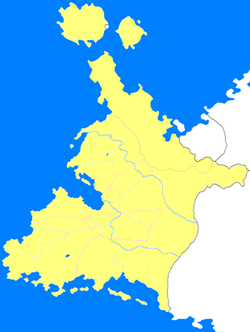Second Kingdom of Batavia
| Second Kingdom of Batavia Tweede Koninkrijk Batavië | |||
|
← | |||
| |||
|
| |||
| Official language: | Batavian | ||
| Capital: | 's Koningenwaarde | ||
| Largest cities: | 's Koningenwaarde, Davignon, Ingelburg | ||
|
| |||
| Population: | 25,367,210 | ||
|
| |||
| Government: | Constitutional monarchy | ||
| Head of state: | Arkadius II des Vinandy | ||
| Head of government: | Gustaaf Vermeylen (first): 1524 - 1526 Max van Bunthe-Uné (last): 1577 - 1579 | ||
| Currency: | Kruys | ||
The Second Kingdom of Batavia, or Tweede Koninkrijk Batavië, was a constitutional monarchy in Batavia, encompassing more than fifty years of the 16th century. The country, headed by king Arkadius II des Vinandy, an elected assembly called the Lagerhuis, an advisory body which made up the Hogerhuis (a chamber of nobles) and the Royal Cabinet with a long series of prime ministers all aided in a stable and functioning regime.
Despite minor domestic conflicts, the country saw its largest expansions during this era. In Benacia it annexed and integrated eastern territories (Ashkenatza Minor, Catologum and Benacium) and northern territories (Gasconje, Shala and Ravaria), through both peaceful and more violent ways (the Gascony War, for example). Farther for home, the nation embarked on a civilization mission in both Keltia and Cibola. Their Cibolan conquests would make up what later would become the First Empire Jingdaoese, while its island possessions in Keltia would remain into the fold.
The nation saw an economic growth, increase in population and trade. Diplomatically, the Batavian Empire was befriended with nations like Shireroth and kept a friendly rivalry with the Republic of Flanders.


